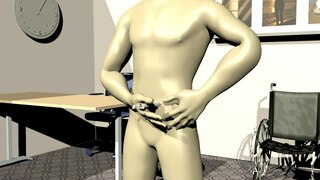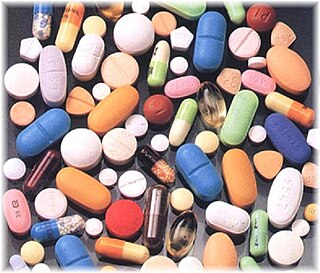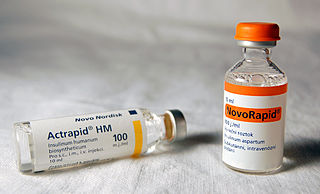Related Research Articles

Metformin, sold under the brand name Glucophage, among others, is the main first-line medication for the treatment of type 2 diabetes, particularly in people who are overweight. It is also used in the treatment of polycystic ovary syndrome. It is sometimes used as an off-label adjunct to lessen the risk of metabolic syndrome in people who take antipsychotics. Metformin is not associated with weight gain and is taken by mouth.

Subcutaneous administration is the insertion of medications beneath the skin either by injection or infusion.

Pioglitazone, sold under the brand name Actos among others, is an anti-diabetic medication used to treat type 2 diabetes. It may be used with metformin, a sulfonylurea, or insulin. Use is recommended together with exercise and diet. It is not recommended in type 1 diabetes. It is taken by mouth.

Polypharmacy (polypragmasia) is an umbrella term to describe the simultaneous use of multiple medicines by a patient for their conditions. The term polypharmacy is often defined as regularly taking five or more medicines but there is no standard definition and the term has also been used in the context of when a person is prescribed 2 or more medications at the same time. Polypharmacy may be the consequence of having multiple long-term conditions, also known as multimorbidity and is more common in people who are older. In some cases, an excessive number of medications at the same time is worrisome, especially for people who are older with many chronic health conditions, because this increases the risk of an adverse event in that population. In many cases, polypharmacy cannot be avoided, but 'appropriate polypharmacy' practices are encouraged to decrease the risk of adverse effects. Appropriate polypharmacy is defined as the practice of prescribing for a person who has multiple conditions or complex health needs by ensuring that medications prescribed are optimized and follow 'best evidence' practices.

Insulin glargine sold under the brand name Lantus among others is a long-acting modified form of medical insulin, used in the management of type I and type II diabetes. It is injected just under the skin. Effects generally begin an hour after use.

Glibenclamide, also known as glyburide, is an antidiabetic medication used to treat type 2 diabetes. It is recommended that it be taken together with diet and exercise. It may be used with other antidiabetic medication. It is not recommended for use by itself in type 1 diabetes. It is taken by mouth.

Exenatide, sold under the brand name Byetta and Bydureon among others, is a medication used to treat diabetes mellitus type 2. It is used together with diet, exercise, and potentially other antidiabetic medication. It is a treatment option after metformin and sulfonylureas. It is given by injection under the skin twice daily or once weekly.
In medicine, patient compliance describes the degree to which a patient correctly follows medical advice. Most commonly, it refers to medication or drug compliance, but it can also apply to other situations such as medical device use, self care, self-directed exercises, or therapy sessions. Both patient and health-care provider affect compliance, and a positive physician-patient relationship is the most important factor in improving compliance. Access to care plays a role in patient adherence, whereby greater wait times to access care contributing to greater absenteeism. The cost of prescription medication also plays a major role.

Sitagliptin, sold under the brand name Januvia among others, is an anti-diabetic medication used to treat type 2 diabetes. In the United Kingdom it is listed as less preferred than metformin or a sulfonylurea. It is taken by mouth. It is also available in the fixed-dose combination medication sitagliptin/metformin.
Benfluorex, sold under the brand name Mediator, is an anorectic and hypolipidemic agent that is structurally related to fenfluramine. It may improve glycemic control and decrease insulin resistance in people with poorly controlled type-2 diabetes.
Medication costs, also known as drug costs are a common health care cost for many people and health care systems. Prescription costs are the costs to the end consumer. Medication costs are influenced by multiple factors such as patents, stakeholder influence, and marketing expenses. A number of countries including Canada, parts of Europe, and Brazil use external reference pricing as a means to compare drug prices and to determine a base price for a particular medication. Other countries use pharmacoeconomics, which looks at the cost/benefit of a product in terms of quality of life, alternative treatments, and cost reduction or avoidance in other parts of the health care system. Structures like the UK's National Institute for Health and Clinical Excellence and to a lesser extent Canada's Common Drug Review evaluate products in this way.
Glucagon-like peptide-1 (GLP-1) receptor agonists, also known as GLP-1 analogs, GLP-1DAs or incretin mimetics, are a class of drugs that reduce blood sugar and energy intake by activating the GLP-1 receptor. They mimic the actions of the endogenous incretin hormone GLP-1 that is released by the gut after eating.

As a medication, insulin is any pharmaceutical preparation of the protein hormone insulin that is used to treat high blood glucose. Such conditions include type 1 diabetes, type 2 diabetes, gestational diabetes, and complications of diabetes such as diabetic ketoacidosis and hyperosmolar hyperglycemic states. Insulin is also used along with glucose to treat hyperkalemia. Typically it is given by injection under the skin, but some forms may also be used by injection into a vein or muscle. There are various types of insulin, suitable for various time spans. The types are often all called insulin in the broad sense, although in a more precise sense, insulin is identical to the naturally occurring molecule whereas insulin analogues have slightly different molecules that allow for modified time of action. It is on the World Health Organization's List of Essential Medicines. In 2020, regular human insulin was the 307th most commonly prescribed medication in the United States, with more than 1 million prescriptions.
A medical abortion, also known as medication abortion or non-surgical abortion, occurs when drugs (medication) are used to bring about an abortion. Medical abortions are an alternative to surgical abortions such as vacuum aspiration or dilation and curettage. Medical abortions are more common than surgical abortions in most places around the world.

Dulaglutide, sold under the brand name Trulicity among others, is a medication used for the treatment of type 2 diabetes in combination with diet and exercise. It is also approved in the United States for the reduction of major adverse cardiovascular events in adults with type 2 diabetes who have established cardiovascular disease or multiple cardiovascular risk factors. It is a once-weekly injection.
SGLT2 inhibitors, also called gliflozins or flozins, are a class of medications that inhibit sodium-glucose transport proteins in the nephron, unlike SGLT1 inhibitors that perform a similar function in the intestinal mucosa. The foremost metabolic effect of this is to inhibit reabsorption of glucose in the kidney and therefore lower blood sugar. They act by inhibiting sodium-glucose transport protein 2 (SGLT2). SGLT2 inhibitors are used in the treatment of type 2 diabetes. Apart from blood sugar control, gliflozins have been shown to provide significant cardiovascular benefit in people with type 2 diabetes. As of 2014, several medications of this class had been approved or were under development. In studies on canagliflozin, a member of this class, the medication was found to enhance blood sugar control as well as reduce body weight and systolic and diastolic blood pressure.
Sotagliflozin, sold under the brand name Inpefa among others, is a medication used to reduce the risk of death due to heart failure.

An injector pen is a device used for injecting medication under the skin. First introduced in the 1980s, injector pens are designed to make injectable medication easier and more convenient to use, thus increasing patient adherence. The primary difference between injector pens and traditional vial and syringe administration is the easier use of an injector pen by people with low dexterity, poor vision, or who need portability to administer medicine on time. Injector pens also decrease the fear or adversity towards self-injection of medications, which increases the likelihood that a person takes the medication.
Insulin degludec/insulin aspart, sold under the brand name Ryzodeg, is a fixed-dose combination medication for the treatment of diabetes mellitus. It contains insulin degludec and insulin aspart. It is given as an injection under the skin in the abdominal wall, upper arm or thigh.

Tirzepatide, sold under the brand names Mounjaro and Zepbound, is an antidiabetic medication used for the treatment of type 2 diabetes and for weight loss. Tirzepatide is administered through subcutaneous injection.
References
- 1 2 3 WEXLER, ANNA (2022). "Mapping the Landscape of Do-it-Yourself Medicine". Citizen Science: Theory and Practice. 7 (1): 38. doi: 10.5334/cstp.553 . ISSN 2057-4991. PMC 9830450 . PMID 36632334.
- ↑ Demonaco, Harold; Oliveira, Pedro; Torrance, Andrew; von Hippel, Christiana; von Hippel, Eric (2020). "When patients become innovators". Managing Innovation in a Global and Digital World: Meeting Societal Challenges and Enhancing Competitiveness. Springer Fachmedien. pp. 121–129. ISBN 978-3-658-27241-8.
- 1 2 Fainzang, Sylvie (1 September 2013). "The Other Side of Medicalization: Self-Medicalization and Self-Medication" (PDF). Culture, Medicine, and Psychiatry. 37 (3): 488–504. doi:10.1007/s11013-013-9330-2. PMID 23820755. S2CID 35393482.
- ↑ "This Drug Could Be the Next Ozempic. Bootlegs Are Already Selling Online". Wall Street Journal. 20 October 2023. Retrieved 15 December 2023.
- ↑ "Barriers to trans care lead some to embrace a do-it-yourself approach". NBC News. 5 July 2023. Retrieved 15 December 2023.
- 1 2 Verma, Nisha; Grossman, Daniel (2023). "Self-Managed Abortion in the United States". Current Obstetrics and Gynecology Reports. 12 (2): 70–75. doi:10.1007/s13669-023-00354-x. ISSN 2161-3303. PMC 9989574 . PMID 37305376.
- ↑ "Can DIY Medicine Tame Rampaging Healthcare Costs?". The Rheumatologist. Retrieved 15 December 2023.
- 1 2 Oberhaus, Daniel (26 July 2018). "Meet the Anarchists Making Their Own Medicine". Vice. Retrieved 15 December 2023.
- ↑ Richterich, Annika (3 May 2020). "When open source design is vital: critical making of DIY healthcare equipment during the COVID-19 pandemic". Health Sociology Review. 29 (2): 158–167. doi: 10.1080/14461242.2020.1784772 . PMID 33411651.
- ↑ Burnside, Mercedes; Crocket, Hamish; Mayo, Michael; Pickering, John; Tappe, Adrian; de Bock, Martin (September 2020). "Do-It-Yourself Automated Insulin Delivery: A Leading Example of the Democratization of Medicine". Journal of Diabetes Science and Technology. 14 (5): 878–882. doi:10.1177/1932296819890623. PMC 7753855 . PMID 31876179.
- ↑ Roberts, Joseph T.F.; Moore, Victoria; Quigley, Muireann (March 2021). "Prescribing unapproved medical devices? The case of DIY artificial pancreas systems". Medical Law International. 21 (1): 42–68. doi:10.1177/0968533221997510. PMC 8053740 . PMID 33958837.
- ↑ Heinemann, Lutz; Lange, Karin (November 2020). ""Do It Yourself" (DIY)—Automated Insulin Delivery (AID) Systems: Current Status From a German Point of View". Journal of Diabetes Science and Technology. 14 (6): 1028–1034. doi:10.1177/1932296819889641. PMC 7645134 . PMID 31875681.
- ↑ Wexler, Anna (1 March 2017). "Recurrent themes in the history of the home use of electrical stimulation: Transcranial direct current stimulation (tDCS) and the medical battery (1870–1920)". Brain Stimulation. 10 (2): 187–195. doi:10.1016/j.brs.2016.11.081. ISSN 1935-861X. PMID 27965065. S2CID 21868698.
- ↑ Ekekezie, Chiazotam; Perler, Bryce K.; Wexler, Anna; Duff, Catherine; Lillis, Christian John; Kelly, Colleen R. (April 2020). "Understanding the Scope of Do-It-Yourself Fecal Microbiota Transplant". The American Journal of Gastroenterology. 115 (4): 603–607. doi:10.14309/ajg.0000000000000499. ISSN 0002-9270. PMC 7359198 . PMID 31972620.
- ↑ Edenfield, Avery C.; Holmes, Steve; Colton, Jared S. (3 July 2019). "Queering Tactical Technical Communication: DIY HRT". Technical Communication Quarterly. 28 (3): 177–191. doi:10.1080/10572252.2019.1607906. S2CID 151159278.
- ↑ Jannini, Emmanuele A.; Lenzi, Andrea; Isidori, Andrea; Fabbri, Andrea (September 2006). "COMMENTARY: Subclinical Erectile Dysfunction: Proposal for a Novel Taxonomic Category in Sexual Medicine". The Journal of Sexual Medicine. 3 (5): 787–794. doi:10.1111/j.1743-6109.2006.00287.x. PMID 16942523.
- 1 2 Lavorgna, Anita (March 2015). "The online trade in counterfeit pharmaceuticals: New criminal opportunities, trends and challenges". European Journal of Criminology. 12 (2): 226–241. doi:10.1177/1477370814554722. S2CID 145354387.
- ↑ "Viagra can be sold over the counter". 28 November 2017. Retrieved 15 December 2023.
- ↑ Hall, Alexandra; Koenraadt, Rosa; Antonopoulos, Georgios A. (December 2017). "Illicit pharmaceutical networks in Europe: organising the illicit medicine market in the United Kingdom and the Netherlands". Trends in Organized Crime. 20 (3–4): 296–315. doi:10.1007/s12117-017-9304-9. hdl: 1874/362451 . S2CID 255516752.
- ↑ Fincham, Jack E. (March 2021). "Negative Consequences of the Widespread and Inappropriate Easy Access to Purchasing Prescription Medications on the Internet". American Health & Drug Benefits. 14 (1): 22–28. ISSN 1942-2962. PMC 8025924 . PMID 33841622.
- ↑ Moseson, Heidi; Bullard, Kimberley A.; Cisternas, Carolina; Grosso, Belén; Vera, Verónica; Gerdts, Caitlin (August 2020). "Effectiveness of self-managed medication abortion between 13 and 24 weeks gestation: A retrospective review of case records from accompaniment groups in Argentina, Chile, and Ecuador". Contraception. 102 (2): 91–98. doi:10.1016/j.contraception.2020.04.015. PMID 32360817. S2CID 218490175.
- ↑ Berer, Marge (2020). "Reconceptualizing safe abortion and abortion services in the age of abortion pills: A discussion paper". Best Practice & Research Clinical Obstetrics & Gynaecology. 63: 45–55. doi:10.1016/j.bpobgyn.2019.07.012. PMID 31494046. S2CID 201156994.
- ↑ Jackson, Emily (2015). "DIY Abortion and Harm Reduction". Inspiring a Medico-Legal Revolution. Routledge. doi:10.4324/9781315588797. ISBN 978-1-315-58879-7.